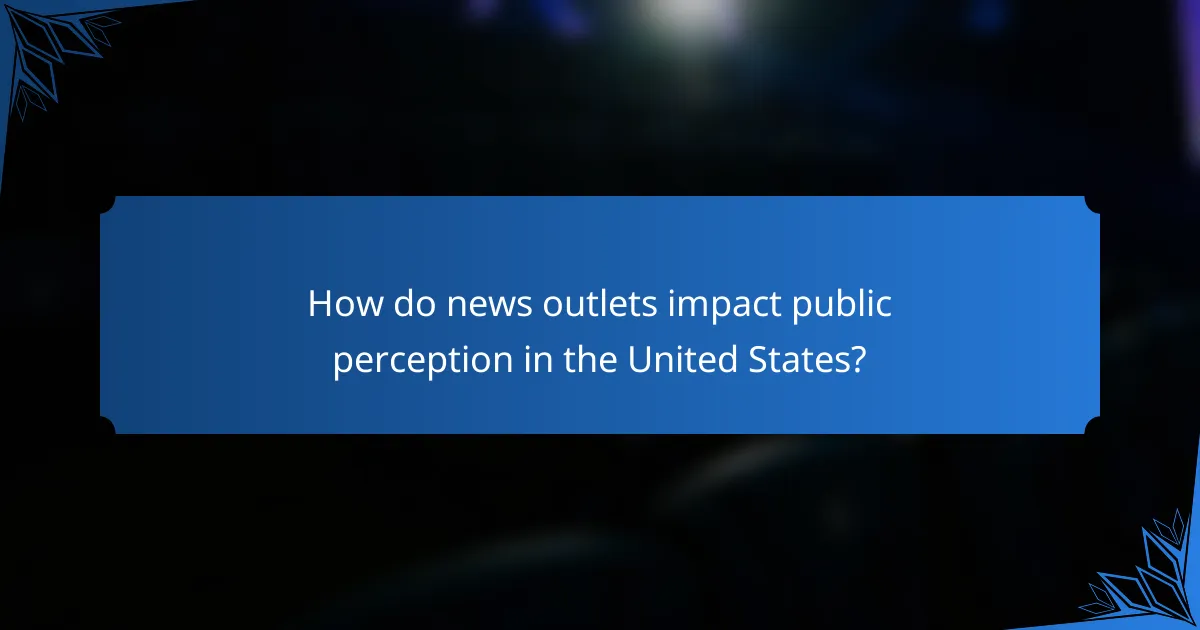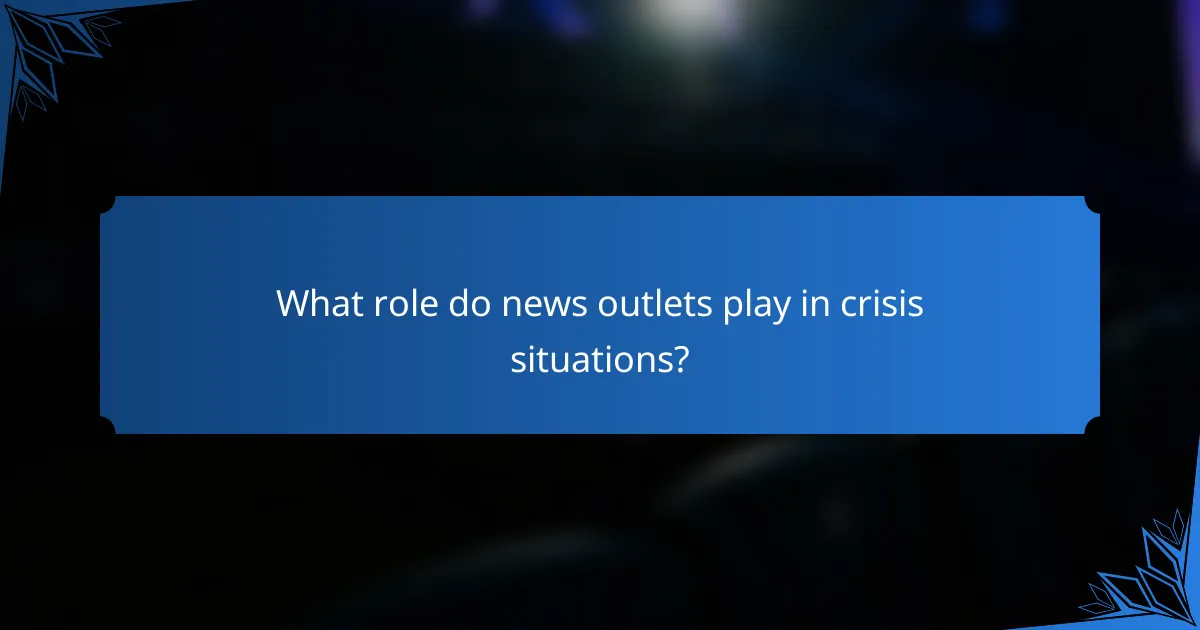News outlets play a crucial role in shaping public perception by influencing the presentation and interpretation of information. Their credibility hinges on rigorous fact-checking, editorial standards, and transparency, which in turn affects public trust. The quality of coverage varies among outlets, influenced by ownership and target audiences, impacting both credibility and the depth of reporting.

How do news outlets impact public perception in the United States?
News outlets significantly shape public perception in the United States by influencing how information is presented and interpreted. Their coverage can sway opinions on political issues, cultural narratives, and social movements, ultimately affecting the collective mindset of the populace.
Influence on political opinions
News outlets play a crucial role in forming political opinions by selecting which stories to cover and how to frame them. For instance, a focus on certain policies or events can lead to increased public awareness and support or opposition among viewers. The tone and language used in reporting can also impact how individuals perceive political figures and their policies.
Moreover, partisan news sources may reinforce existing beliefs, creating echo chambers that further polarize opinions. This can result in a significant divide in public sentiment, as consumers gravitate towards outlets that align with their views.
Shaping cultural narratives
News outlets contribute to shaping cultural narratives by highlighting specific issues, events, or trends that resonate with the public. This can include topics such as social justice, climate change, or technological advancements. By providing a platform for diverse voices, they can either challenge or reinforce prevailing cultural norms.
For example, extensive coverage of movements like Black Lives Matter or [censured] rights has helped elevate these issues in the national conversation, fostering greater awareness and dialogue. The portrayal of these narratives can influence societal values and behaviors over time.
Impact on social movements
News coverage is vital for the visibility and success of social movements. Outlets that report on protests, advocacy efforts, and grassroots campaigns can mobilize public support and attract attention from policymakers. Effective media strategies can amplify a movement’s message and encourage wider participation.
However, the framing of these movements can also lead to misrepresentation or backlash. It’s essential for activists to engage with media thoughtfully, ensuring their narratives are accurately conveyed to foster understanding and support among the broader public.

What factors determine the credibility of news outlets?
The credibility of news outlets is primarily determined by their adherence to rigorous fact-checking processes, established editorial standards, and transparency in sourcing information. These factors collectively influence public trust and the perceived reliability of the news being reported.
Fact-checking processes
Fact-checking processes are essential for verifying the accuracy of information before publication. Reputable news outlets typically employ dedicated teams or collaborate with independent fact-checking organizations to assess claims and data presented in their articles.
For example, a credible outlet may take several hours to verify a breaking news story, cross-referencing multiple sources to ensure accuracy. This diligence helps prevent the spread of misinformation and enhances the outlet’s reliability.
Editorial standards
Editorial standards refer to the guidelines that govern how news is reported and presented. These standards often include principles like impartiality, accuracy, and fairness, which are crucial for maintaining credibility.
News organizations may publish their editorial guidelines, allowing readers to understand their commitment to quality journalism. Outlets that consistently adhere to high editorial standards are more likely to be trusted by their audience.
Transparency in sourcing
Transparency in sourcing involves clearly indicating where information comes from, which is vital for establishing credibility. Credible news outlets often cite sources, provide links to original documents, or mention expert opinions to support their claims.
For instance, if a news article discusses a scientific study, a reputable outlet will typically include a reference to the study itself, allowing readers to verify the information. This practice not only builds trust but also encourages accountability in journalism.

How do different news outlets compare in coverage quality?
Different news outlets exhibit varying levels of coverage quality, influenced by their ownership, editorial policies, and target audiences. Mainstream outlets often prioritize broad appeal and adherence to journalistic standards, while independent and local outlets may focus on niche topics or community issues, affecting their credibility and depth of coverage.
Mainstream vs. independent outlets
Mainstream news outlets, such as major television networks and national newspapers, typically have extensive resources and established credibility. They often adhere to strict editorial guidelines and fact-checking processes, which can enhance their reliability.
In contrast, independent outlets may offer unique perspectives and in-depth reporting on specific issues, but they might lack the same level of resources or oversight. This can lead to variability in coverage quality, making it essential for consumers to evaluate the credibility of independent sources carefully.
Local news vs. national news
Local news outlets focus on community-specific events and issues, providing detailed coverage that national outlets might overlook. This localized approach allows for a deeper understanding of regional concerns, but it may also lead to a narrower perspective on broader issues.
National news outlets cover significant events and trends across the country, often providing context and analysis. However, their coverage may lack the depth of local reporting, as they prioritize stories with wider appeal. Readers should consider both types of news to gain a comprehensive view of current events.
International news coverage
International news coverage varies significantly among outlets, with some focusing on major geopolitical events while others may highlight underreported stories. Established international news organizations often provide in-depth analysis and context, which can enhance understanding of complex global issues.
However, smaller or less reputable outlets may sensationalize international news or present biased perspectives. It’s crucial for readers to cross-reference multiple sources to ensure a balanced understanding of international events and their implications.

What role do news outlets play in crisis situations?
News outlets serve a critical function in crisis situations by providing timely and accurate information to the public. They help shape the narrative, inform citizens about safety measures, and facilitate community engagement during emergencies.
Information dissemination during emergencies
During emergencies, news outlets are essential for disseminating vital information quickly. They report on unfolding events, share updates from authorities, and provide guidance on safety protocols. This rapid communication can significantly influence public behavior and decision-making.
For example, during natural disasters like hurricanes or wildfires, news channels often broadcast real-time updates on evacuation orders, shelter locations, and safety tips. This information can save lives and reduce panic among the population.
Public safety announcements
News outlets play a key role in broadcasting public safety announcements that inform citizens about potential dangers. These announcements can include alerts about severe weather, health advisories, or security threats. The clarity and reach of these messages are crucial for effective public response.
Typically, local news stations collaborate with government agencies to ensure that critical information is communicated effectively. For instance, during a health crisis, news outlets may relay updates on vaccination sites and safety guidelines, helping to keep the community informed and safe.
Community engagement
In crisis situations, news outlets foster community engagement by encouraging dialogue and interaction among residents. They often provide platforms for local voices, allowing citizens to share their experiences and concerns. This engagement can enhance community solidarity and resilience.
Moreover, news outlets may host forums or social media discussions where community members can ask questions and receive real-time responses from experts. This not only informs the public but also builds trust between the media and the community during challenging times.

How can consumers evaluate news outlet credibility?
Consumers can evaluate news outlet credibility by examining the source’s reputation, understanding its biases, and utilizing media literacy tools. This process involves critical thinking and awareness of the information landscape to distinguish reliable news from misinformation.
Identifying bias and perspective
Recognizing bias and perspective is crucial for evaluating news credibility. Different outlets may have political affiliations or editorial slants that influence their reporting. For instance, a news organization that consistently favors one political party may present information in a way that aligns with that ideology.
To identify bias, consider the language used in articles, the selection of topics covered, and the framing of issues. Tools like media bias charts can help visualize where various outlets fall on the bias spectrum, aiding consumers in making informed choices.
Assessing source reliability
Assessing the reliability of a news source involves checking its history, ownership, and editorial standards. Established outlets with a long track record of journalistic integrity are generally more trustworthy. Look for transparency in reporting, such as citing sources and providing evidence for claims made.
Additionally, consider cross-referencing information with multiple reputable sources. If several credible outlets report the same facts, the likelihood of accuracy increases. Be cautious of sources that lack accountability or have a history of spreading misinformation.
Using media literacy tools
Media literacy tools can enhance consumers’ ability to evaluate news credibility effectively. Websites like FactCheck.org and Snopes.com provide fact-checking services that verify claims made in the media. These resources can help consumers discern factual reporting from sensationalism or falsehoods.
Moreover, educational programs on media literacy are increasingly available, teaching skills to critically analyze news content. Engaging with these resources can empower consumers to navigate the complex media landscape with greater confidence and discernment.

What are the emerging trends in news outlet coverage?
Emerging trends in news outlet coverage include the rise of digital platforms, the impact of social media on news distribution, and an increased focus on local journalism. These trends are reshaping how news is produced, consumed, and prioritized by audiences.
Rise of digital platforms
The rise of digital platforms has transformed traditional news outlets into multimedia hubs. Many news organizations now prioritize online content, utilizing websites, podcasts, and video streaming to reach broader audiences. This shift allows for more interactive and engaging storytelling, catering to the preferences of younger demographics.
News outlets must adapt to this digital landscape by investing in technology and training staff to create compelling online content. Emphasizing user experience and mobile accessibility is crucial, as a significant portion of readers access news via smartphones and tablets.
Impact of social media on news distribution
Social media has significantly altered news distribution, enabling real-time sharing and engagement. Platforms like Twitter, Facebook, and Instagram allow news outlets to disseminate information quickly, reaching millions instantly. However, this speed can lead to the spread of misinformation if outlets do not verify facts before posting.
To navigate this challenge, news organizations should establish clear guidelines for social media use, emphasizing accuracy over speed. Engaging with audiences through comments and shares can also enhance credibility and foster community trust.
Increased focus on local journalism
There is a growing emphasis on local journalism as communities seek reliable news sources that address their specific needs. Local news outlets are increasingly prioritizing stories that impact their regions, from city council meetings to local events. This trend helps to strengthen community ties and inform citizens about issues that matter most to them.
To effectively serve local audiences, news organizations should consider partnerships with community groups and utilize feedback from readers to guide coverage. Investing in investigative reporting at the local level can also enhance credibility and attract a loyal readership.



